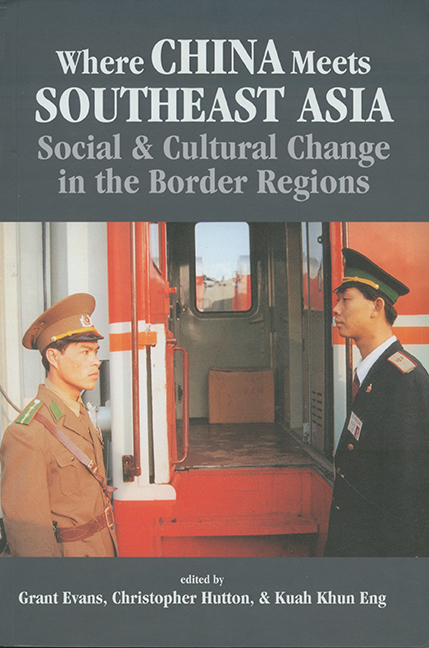Book contents
- Frontmatter
- Contents
- Contributors
- Map
- Introduction: The Disappearing Frontier?
- 1 Where Nothing Is as It Seems: Between Southeast China and Mainland Southeast Asia in the “Post-Socialist” Era
- 2 The Southern Chinese Borders in History
- 3 Ecology Without Borders
- 4 Negotiating Central, Provincial, and County Policies: Border Trading in South China
- 5 The Hmong of the Southeast Asia Massif: Their Recent History of Migration
- 6 Regional Trade in Northwestern Laos: An Initial Assessment of the Economic Quadrangle
- 7 Lue across Borders: Pilgrimage and the Muang Sing Reliquary in Northern Laos
- 8 Transformation of Jinghong, Xishuangbanna, PRC
- 9 The Hell of Good Intentions: Some Preliminary Thoughts on Opium in the Political Ecology of the Trade in Girls and Women
- 10 Cross-Border Mobility and Social Networks: Akha Caravan Traders
- 11 Cross-Border Links between Muslims in Yunnan and Northern Thailand: Identity and Economic Networks
- 12 Trade Activities of the Hoa along the Sino-Vietnamese Border
- 13 Cross-Border Categories: Ethnic Chinese and the Sino-Vietnamese Border at Mong Cai
- 14 Regional Development and Cross-Border Cultural Linkage: The Case of a Vietnamese Community in Guangxi, China
- 15 Women and Social Change along the Vietnam-Guangxi Border
- Index
8 - Transformation of Jinghong, Xishuangbanna, PRC
Published online by Cambridge University Press: 21 October 2015
- Frontmatter
- Contents
- Contributors
- Map
- Introduction: The Disappearing Frontier?
- 1 Where Nothing Is as It Seems: Between Southeast China and Mainland Southeast Asia in the “Post-Socialist” Era
- 2 The Southern Chinese Borders in History
- 3 Ecology Without Borders
- 4 Negotiating Central, Provincial, and County Policies: Border Trading in South China
- 5 The Hmong of the Southeast Asia Massif: Their Recent History of Migration
- 6 Regional Trade in Northwestern Laos: An Initial Assessment of the Economic Quadrangle
- 7 Lue across Borders: Pilgrimage and the Muang Sing Reliquary in Northern Laos
- 8 Transformation of Jinghong, Xishuangbanna, PRC
- 9 The Hell of Good Intentions: Some Preliminary Thoughts on Opium in the Political Ecology of the Trade in Girls and Women
- 10 Cross-Border Mobility and Social Networks: Akha Caravan Traders
- 11 Cross-Border Links between Muslims in Yunnan and Northern Thailand: Identity and Economic Networks
- 12 Trade Activities of the Hoa along the Sino-Vietnamese Border
- 13 Cross-Border Categories: Ethnic Chinese and the Sino-Vietnamese Border at Mong Cai
- 14 Regional Development and Cross-Border Cultural Linkage: The Case of a Vietnamese Community in Guangxi, China
- 15 Women and Social Change along the Vietnam-Guangxi Border
- Index
Summary
The opening up of the land borders between China and the mainland Southeast Asian states has not only involved economic processes, but also social and cultural ones, such as shifts in ethnic composition along the border. In some cases it has seen the re-establishment of a previous status quo, such as the return of ethnic Chinese (Hoa) traders to the northern borders of Vietnam. During the conflict with China along the border in the late 1970s and early 1980s, the Hoa were compelled to move away from the border for “security” reasons, and many fled Vietnam as refugees. Today, they have moved back in strength, and border towns like Mong Cai or Lang Son once again have large and thriving Hoa populations (see Chapter 12).
By comparison, the towns inside Laos along its border with China have always been small, and the volume of trade low. The ethnic Lao are in a minority in the provinces of Phongsaly, Oudomxay, and Luang Namtha, all of which have ethnically very mixed populations of Khmu, Lue, Hmong, Goh (Akha), Phu Noi, Haw (Yunnanese Chinese), and others. While Haw have always played an important trading role and tended to base themselves in the towns, the boundary between ethnic Chinese towns and ethnic “other” rural areas has been blurred.
For example, Haw (who are sometimes thought of as a “hilltribe”) also engage in slash-and-burn upland cultivation. Many Chinese left Laos after the 1975 communist take-over, including a significant number of Haw from the north, and the subsequent conflict with China in the late 1970s caused more to leave, although they were not compelled to do so, as they were in Vietnam. Some, in fact, remained, and they have formed a core for the return of Chinese to the border, including Chinese who have never lived there before. For example, a Lao-Chinese from Pakse in the south of Laos, who had studied Chinese in China, moved to Luang Namtha with his wife from Hubei to act as an interpreter in Lao-Chinese trade, at the same time setting up a small coffee-shop in the main street.
- Type
- Chapter
- Information
- Where China Meets Southeast AsiaSocial and Cultural Change in the Border Regions, pp. 162 - 182Publisher: ISEAS–Yusof Ishak InstitutePrint publication year: 2000



